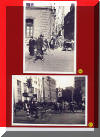![]()
|
|
THE STREETS AND PEOPLE
Prior to the Japanese Proclamation of 1943, restricting Jews to a designated area, Jewish refugees lived all over Shanghai. Except for the new wave of immigrants who arrived from Nazi Europe in the late 30’s,, Jews in Shanghai had risen from a modest to a high level of economic standard. They were the Sephardim Jews who immigrated to Shanghai from British ruled areas like Baghdad, Bombay, and Hong Kong, and Russian Jews who came later in the early 1900 ‘s via Siberia and Harbin, after the pogroms and the revolution in Russia. Of the two existing communities, the Sephardim were the most prosperous and dominated Jewish life in Shanghai. They lived and worked largely in international zones that were administered by the Western nations. The French Concession, particularly as a residential district, was developed because of congestion in the International Settlement. It was founded in 1862 in southwest Shanghai as a result of the Treaty of Nanking. The concession was known for its wide tree-lined streets and interesting European and art deco style architecture. In figure one thru figure three, we see a residential section on Avenue Petain. A typical living room of the early 30 ‘s, located on this avenue, is shown in figure four, and The Grosvenor, a popular apartment complex situated on Route Cardinal Mercier, is shown in figure five. A flourishing business district consisting of coffee houses, nightclubs, and theaters was developed in the section of Avenue Joffre. One of the theaters, The Cathay, located on Avenue Joffre, that featured first- run Hollywood films, is shown in figure six. A second theater, The Doumer, located on Route Doumer, was familiar to many refugees before the war. In figure seven, we see a program of a performance given at The Doumer during the early 40‘s by the newly arrived refugees from Central Europe. Two popular business districts in the French Concession are shown in figure eight and figure nine. They are the Rue du Consulat, and the Rue Lafayette respectively. The French Concession mentioned above was often referred to during its heydays as The Paris of the Orient.
The International Settlement,
approximately twice the size of the French Concession, merged by British and
American Concessions in 1863. Two well know theaters in the Settlement, The Capital on Museum Road, recalled on a leaflet, and The Grand on Bubbling Well Road, are shown in figure 11 and figure 12 respectively. The famous Race- Course and the Park Hotel, also on Bubbling Well Road, are shown in figure 13, and the extension of Bubbling Well Road, in figure 14. The heart of the business section in the Settlement, Soochow Road corner Foochow Road, and the famed Nanking Road are presented in figure 15 thru figure 18. There were also streets lined with stores on Seymour Road and Marco Polo, shown in figure 19 and figure 20 respectively, and on St. George where the Paramount Building was located, shown in figure 21. Both streets were also a busy part of the Settlement. One of several recreational facilities was the popular Jessfield Park located immediately outside the International Settlement. A small part of the park is shown in figure 22. During the first few months of immigration when the last wave of stateless Jews arrived from Germany, Austria, and Poland, most of the refugee patients were sent to Shanghai ~ various municipal and private hospitals. One such hospital, The General Hospital, located in the International Settlement on North Soochow Road, is illustrated on a postcard in figure 23. In 1943, all the foreign concessions where returned to China. After the war began, all stateless refugees, with a few exceptions, were interned at the urging of Japan‘s German allies, in a ghetto located in Hongkew. According to the Proclamation drafted by the Japanese in 1943, stateless refugees meant people who had arrived in Shanghai since 1937 from Central and Eastern Europe. It excluded most of the Russian and Polish Ashkenazi Jews who came earlier to Shanghai. Hongkew, at the time, was no longer a part of the International Settlement, and was governed by the Japanese authorities. The following photos were taken of the ghetto, also referred to as the Designated Area, before the war. The Ward Road Jail, located on Ward Road, is shown in figure 24, and an unidentified street in the Hongkew area in figure 25. Most of the refugees restricted to the designated area were living under extremely primitive conditions. The sharp contrast between the dwellings on Rue Lafayette in the French Concession shown in figure 26, with that of the dwelling of yours truly in Hongkew, shown on a recent photograph in figure 27, is self-explanatory. Figure 28 thru figure 32 show the true natives of Shanghai, mostly the way we remember them. Shanghai will always be remembered in two very distinct manners. To the foreigners and refugees who settled in Shanghai long before the war began, it will be the carefree living among their Chinese neighbors, and the fortune they made, while for the 18,000 to 20,000 Jewish refugees who fled the horrors of Nazism in the late 30‘s, Shanghai will be remembered with gratitude, and how this last place for refuge spared them from the Holocaust.
Footnotes: Thanks go to Andreas Heinsius and Irene Hymann, who through their generosity contributed a large part of the material to my Shanghai archives. |
|
|
|
 Fig. 16 & 17
|